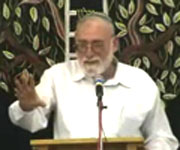Beit Midrash
- Shabbat and Holidays
- Jewish Holidays
- Sukkot
As we know, the High Priest entered the Holy of Holies on Yom Kippur – a place where no one else was ever allowed to enter – and performed the service under the watchful eyes of absolutely no one other than G-d. We too enter a very holy place just a few days later: to our Sukkot. "The King has brought me to His inner chambers, we will rejoice and be happy with you" (Song of Songs 1,4). On the festival of Sukkot, the entire Sukkah is an inner chamber of the King of Kings, and His holiness is upon it.
There is a very profound connection between Sukkah and Mishkan/Mikdash (Tabernacle and Holy Temple). The first large Sukkah in our history was the Mishkan in the Desert – and its construction began on the 15th day of Tishrei. This is why we sit in our Sukkot for a week beginning on that very date [see the calculations and explanation of the Vilna Gaon in his commentary to the above verse].
After several centuries in which our Divine worship took place in the Mishkan, the First Temple was built. King Shlomo dedicated it in regal fashion on the days close to the Sukkot festival (Kings I 8, 65-66). Several laws of the Sukkah were derived from the Mishkan, such as its minimum height and the type of shade it must have.
Sukkah: A Personal Mikdash
On the other hand: While the measurements, structure, and location of both the Mishkan and Mikdash were Divinely determined, a Sukkah is very different. It has certain minimum Halakhic requirements, but aside from these, every person may make it as large or small as he wants, with whatever walls, s'chach (which serves as a roof), decorations, arrangement, utensils, etc. that he chooses. It is each person's choice. Every Sukkah is different, and everyone builds his private Mikdash in accordance with his character and desires.
One can also decide, aside from the minimum requirements, how long he wants to remain in the Sukkah, and what he wants to do there. One can, and must, decide how he fills the expanse that is generally a regular yard or porch, but which is now delimited by walls and s'chach for one week and thus receives dimensions of sanctity.
The Zohar describes the Sukkah as tzila d'mehemnuta, "the shadow of the Divine Presence." The basic obligation to eat meals in the Sukkah is well-known, but beyond that, one can decide how much other time he wishes to spend there, and in what way – i.e., how much sanctity he wishes to absorb. He can choose to make the Sukkah his "permanent home" for the week, in the spirit of the Halakha [Jewish Law] – just as the High Priest does not leave the Holy Temple. Every person is like a High Priest in his own Sukkah.
After the holiday has ended, when we dismantle the Sukkah and put away its walls and poles for the next year, routine returns to the yard and porch – and then we face the need to check what impression the holiday has made upon us. We must ascertain how we will remember Sukkot during the coming year even without the temporary closing up of this space by the Sukkah. Why is this important?
Our ability to close off and delimit a place for a particular duration, and to thus grant it dimensions of holiness, teaches us the tremendous abilities we have, each of us, to create for ourselves frameworks with meaningful and even sacred content of our choice. On Sukkot we determine for ourselves, with our family members, what type of spiritual environment we would like to have, and how we would like to act within it. The Sukkah is a "surrounding light," according to Hassidut, a light that encompasses us. This is a light that challenges us to expand and augment it, and one that enables us to influence and be influenced in the right directions.
The links between the Sukkot and Pesach festivals are both many and fascinating. On Pesach we are commanded to tell the story of the Exodus from Egypt, and on Sukkot, though we don't formally tell the story, we have the obligation to know that we are sitting in the Sukkah because of this same Exodus: "So that your generations will know that in the Sukkot [real ones, and/or Clouds of Glory] I had the Children of Israel dwell when I took them out of Egypt" (Lev. 23,43).
This verse presents us with a strict requirement. Understanding the meaning of sitting in the Sukkah is critical (see Tur and Shulchan Arukh Orach Chaim 625); no other mitzvah requires such a clear understanding for its fulfillment.
The Gemara (Sukkah 2b) explains that the above verse refers to a "knowledge for generations," which means, according to Rabbeinu Chananel, something very similar to the Seder night: "The future generations see the adults building a Sukkah and leaving their homes to dwell in it and ask for an explanation. Their parents are to then tell them all about the Exodus…"
But the parents need relay not only facts to their children. They must also show them how they invest in the Sukkah, the efforts they put in, the joy with which they do this, and the importance that they ascribe to it. This forms a framework of values for the future generations: "So that your generations will know…"
Sukkot is thus the holiday of filling our frameworks with genuine and meaningful content.
Translated by Hillel Fendel

How to Live in the Sukkah
Rabbi Yirmiyohu Kaganoff | Tishrei 8 5780
The Four Species of Sukkot - Victory!
Rabbi Yosef Nave | 14 Tishrei 5784

May I Smell my Esrog and Hadasim on Sukkos?
Rabbi Yirmiyohu Kaganoff | 5769





















